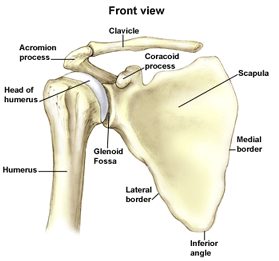|
 |
|
 Frozen shoulder, or adhesive capsulitis, is a condition
that begins with a gradual onset of pain and a limitation of shoulder
motion. The discomfort and loss of movement can become so severe
that even simple daily activities become difficult. Although much
is known about this condition, there continues to be considerable
controversy about its causes and the best ways to treat it.
Frozen shoulder, or adhesive capsulitis, is a condition
that begins with a gradual onset of pain and a limitation of shoulder
motion. The discomfort and loss of movement can become so severe
that even simple daily activities become difficult. Although much
is known about this condition, there continues to be considerable
controversy about its causes and the best ways to treat it.
What
does the inside of the shoulder look like?
The shoulder is the most mobile joint in the human body, with a
complex arrangement of structures working together to provide the
movement necessary for daily life. Unfortunately, this great mobility
comes at the expense of stability. Several bones and a network of soft
tissue structures (ligaments, tendons, and muscles), work together
to produce shoulder movement. They interact to keep the joint in
place while it moves through extreme ranges of motion. Each of these
structures makes an important contribution to shoulder movement
and stability. Certain work or sports activities can put great demands
upon the shoulder, and injury can occur when the limits of movement
are exceeded and/or the individual structures are overloaded. Click
here to read more about shoulder structure.
What is frozen shoulder?
Frozen shoulder, also called adhesive capsulitis, is a thickening
and tightening of the soft tissue capsule that surrounds the glenohumeral
joint, the ball and socket joint of the shoulder. When the capsule
becomes inflamed, scarring occurs and adhesions are formed. This
scar formation greatly intrudes upon the space needed for movement
inside the joint. Pain and severely limited motion often occur as
the result of the tightening of capsular tissue.
There are two types of frozen shoulder: primary adhesive capsulitis
and secondary adhesive capsulitis.
-
Primary
adhesive capsulitis is a subject of much debate. The specific
causes of this condition are not yet known. Possible causes
include changes in the immune system, or biochemical and hormonal
imbalances. Diseases such as diabetes mellitus, and some cardiovascular
and neurological disorders may also be contributing factors.
In fact, patients with diabetes have a three times higher risk
of developing adhesive capsulitis than the general population.
Primary adhesive capsulitis may affect both shoulders (although
this may not happen at the same time) and may be resistant to
most forms of treatment.
-
Secondary
(or acquired) adhesive capsulitis develops from a known cause,
such as stiffness following a shoulder injury, surgery, or a
prolonged period of immobilization.
With no treatment,
the condition tends to last from one to three years. Many patients
are unwilling to endure the pain and limitations of this problem while
waiting for it to run its natural course. Even after many years, some
patients will continue to have some stiffness, but no serious pain
or functional limitations.

© 2017 by LeadingMD.com All rights reserved
Disclaimer
|

